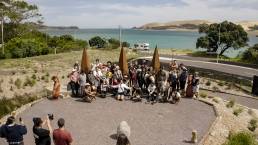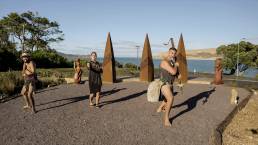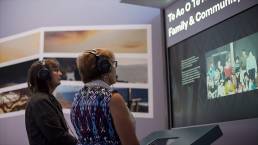It’s always a privilege to share and increase our understanding of the unique insights and histories that are interwoven into iwi-based projects. Clients often give us so many sources of inspiration and reasons for patience.
In bi-cultural or iwi-centred projects, our starting point is always ‘these are your stories, not ours’. We have expertise in presentation, in technology, in exhibition design for audiences, but we’re not the experts in whakapapa or whanaungatanga.
Combining different worlds has to be acknowledged as a strength, as much as it can be a challenging opportunity to grasp. This is especially relevant when defining your audience, even thinking about what values the different manuhiri will bring as they reach the gateway of an experience.

A happy group of manuhiri end their visit at the lookout point where three ancestral waka look out over the heads of the Hokianga Harbour.
Learning to listen first
On the Manea project, for example, we had a breakthrough when we realised some of our challenges arose from our design team’s expectation of visitor behaviour compared to the realities of a Māori experience of being a visitor to another region.
Pākehā creators tend to think that museum exhibition visitors will behave like passive audience members. The expectation is that they’re easily bored, need constant entertainment, and that they crave short little dopamine hits. Whereas a Māori client might expect visitors to behave like their guests – that visitors will be respectful of the host iwi, readily adapting to the kaupapa of an experience design as it reflects on the manaakitanga and mana of the tangata whenua.
We should try not to underestimate the audience, but also remember they don’t all look through the same lens. Ngā mihi mahana to Te Hua o Te Kawariki Trust for that learning opportunity.

Three guides from the haukāinga welcome each visiting group for their Manea experience.
We’ve been very fortunate to be welcomed onto famous marae, into incredible wharenui, and to have received the gifts of shared knowledge from such generous kuia and kaumatua.
Like most things in life, the trick of bi-cultural approaches is to find common ground and use the best of each approach, to reach that magic place – the win-win.
Mā te rongo, ka mōhio; Mā te mōhio; ka mārama; Mā te mārama, ka mātau, Mā te mātau ka ora. From perception, to understanding, to knowledge.
For that, we sometimes should talk less, listen more.
-Gary

Engaging visitors with interactives that reflect different world views takes both collaboration, and a clear sense of purpose.